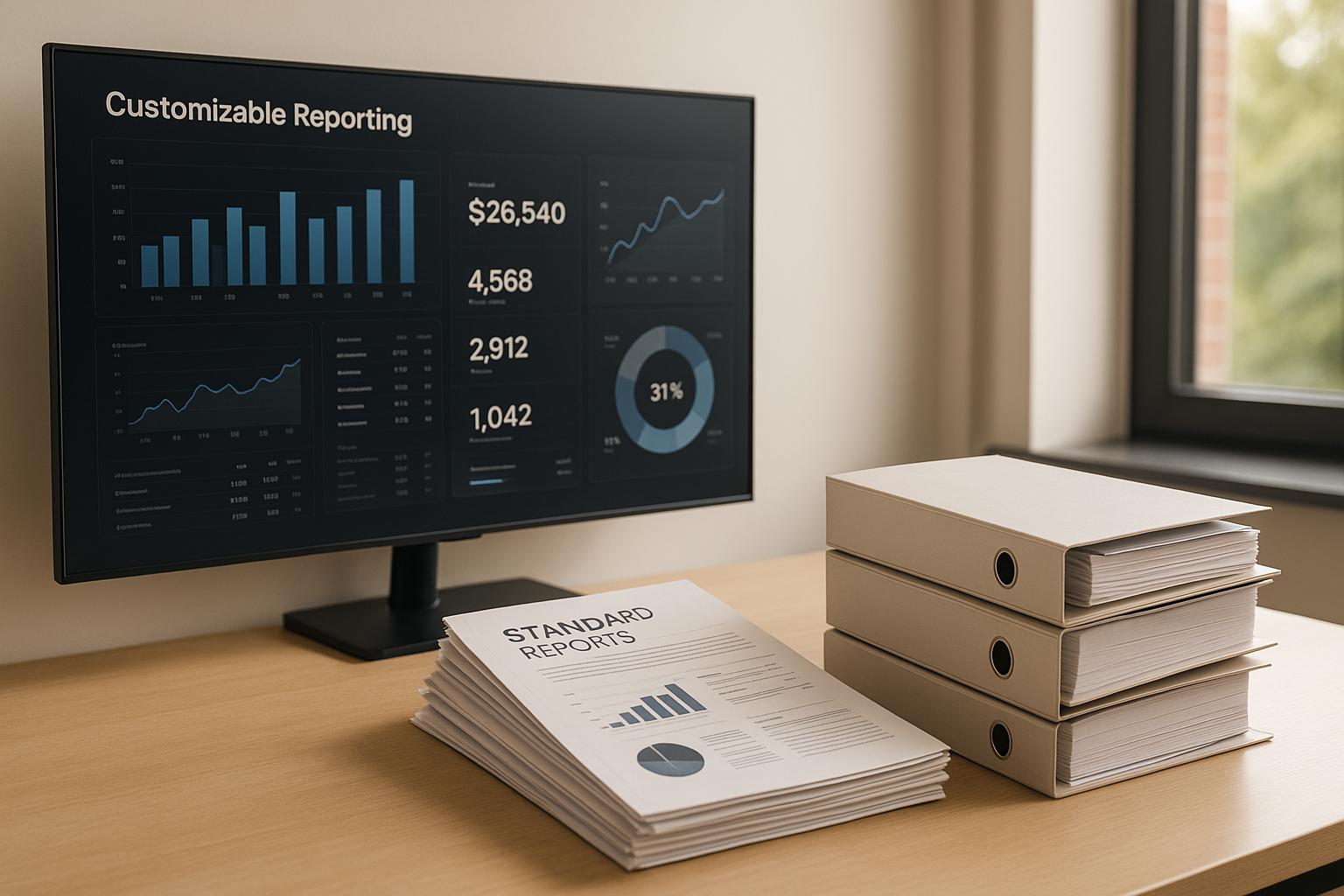Checklist for Accurate Revenue Forecasts

Accurate revenue forecasting is critical for making sound business decisions. It helps you predict income, allocate resources, and build investor confidence. To create reliable forecasts, you need clean data, clear assumptions, and the right tools. Here's a quick summary of the key steps:
- Use Historical Data: Analyze 18–24 months of financial data to identify trends like seasonality and growth patterns.
- Ensure Data Accuracy: Clean and validate data from accounting, CRM, and billing systems to avoid errors.
- Factor in External Data: Include market trends, competitor insights, and economic indicators to add context.
- Define Assumptions: Build scenarios (baseline, optimistic, conservative) based on historical performance and market conditions.
- Leverage Technology: Automate data collection and use forecasting tools to improve accuracy and efficiency.
- Regularly Review and Adjust: Conduct monthly variance analyses and update forecasts as new data emerges.
Avoid pitfalls like overly optimistic assumptions, incomplete data, and lack of team collaboration. By following these steps, you can create forecasts that guide smarter decisions and support sustainable growth.
Prerequisites for Reliable Revenue Forecasts
Creating dependable revenue forecasts starts with a solid base of accurate and well-organized data. The reliability of your projections hinges on the quality of the information you use. Without proper data collection and validation, even advanced forecasting methods can lead to misleading results.
Collect Historical Financial Data
The backbone of any accurate revenue forecast is 18–24 months of historical financial data. This timeframe offers enough detail to uncover seasonal patterns, growth trends, and cyclical shifts that shorter periods may fail to reveal.
Start by gathering data from all relevant systems to ensure a complete picture of your revenue. Pull from your accounting systems for insights into revenue recognition, cash flow, and expenses. Use your CRM platforms to analyze sales pipelines, conversion rates, and customer acquisition trends. Include data from billing tools to track recurring revenue, payment schedules, and customer behaviors.
For SaaS companies, key metrics like monthly recurring revenue (MRR), annual recurring revenue (ARR), churn rates, and expansion revenue are essential. Meanwhile, traditional businesses should focus on sales cycles, seasonal shifts, and customer purchasing habits.
Breaking down this historical data through segmentation and cohort analysis often uncovers insights that aggregate figures conceal. For example, you might find that customers from specific acquisition channels generate higher lifetime value or that certain products exhibit unique seasonal trends. These granular insights are critical for building more precise forward-looking projections.
"Hire PSG if you want to make your life easier and have accurate data." - Michael Mancuso, CIO, New Law Business Model
Ensure Data Integrity
To get reliable forecasts, your data must be consistent and error-free. This requires systematic cleaning and validation across all systems.
Start by reconciling records between your accounting, billing, and CRM systems. Discrepancies often point to timing issues, duplicate entries, or missing transactions that need attention. Ensure customer records and transactions aren’t duplicated, as this could inflate performance metrics. For instance, a single customer might appear differently in your CRM and billing tools, or a transaction may be recorded multiple times due to system overlaps.
Keep detailed audit trails for every adjustment made. These records are invaluable for transparency and for refining your processes over time. Regular documentation also makes it easier to evaluate forecast accuracy and improve your approach.
Automating data updates can significantly enhance both the reliability and timeliness of your models. Set up routine checks to catch errors, broken formulas, or outdated links in your forecasting tools. Monthly variance tracking - comparing forecasted results to actual outcomes - can highlight recurring issues in your data processes. Keeping your data clean is a crucial step before diving into the next stages of forecasting.
Incorporate External Market Data
Internal data is essential, but external market data adds context and helps align forecasts with broader economic trends.
Industry trends often influence your revenue trajectory, regardless of your internal performance. Factors like market consolidation, regulatory changes, or technological shifts should shape your forecasting assumptions. Use resources like market research reports, industry publications, and trade association data to benchmark your growth expectations.
Competitive intelligence is another valuable input. While you may not have access to competitors' financial details, public information - such as their growth rates, market share changes, or strategic moves - can help you gauge your performance relative to the industry.
Additionally, macroeconomic indicators like interest rates, unemployment levels, and consumer confidence indices can provide insights into external factors affecting your business. For example, B2B companies may be more influenced by shifts in business investment, while consumer-facing businesses might track retail spending and sentiment.
The key is integrating external data with your internal metrics. Use external insights to challenge your assumptions and create scenario-based forecasts. This approach prepares you for various market conditions while keeping the focus on factors you can control. Combining internal and external data sets the stage for effective forecast modeling.
Phoenix Strategy Group works with growth-stage companies to streamline the collection, integration, and analysis of both internal and external data. Their expertise in data engineering and financial planning helps businesses build a strong foundation for reliable revenue forecasting.
Step-by-Step Checklist for Revenue Forecasting
Using verified data, these steps guide you through creating accurate revenue forecasts. This structured approach simplifies the process, making it easier for growth-stage businesses to develop reliable projections.
Analyze Historical Revenue Trends
Start by examining your past revenue data to uncover patterns that can inform future projections. Go beyond basic growth rates and dig into the factors driving your revenue changes.
Pay attention to seasonality. For instance, retail businesses often see sales spikes during the holidays, while B2B software companies might experience slower growth in the summer when decision-makers are out of the office. Instead of relying on a single growth rate, analyze trends over 3-month, 6-month, and 12-month periods to get a clearer picture of how your growth is evolving.
Take a close look at customer behavior. This includes churn rates, revenue from existing customers, and how average deal sizes change over time. Break your revenue down into categories like new business, renewals, and expansion revenue. This breakdown helps pinpoint which areas of your business are thriving and which need attention, enabling more precise forecasting.
Once you've identified these trends, quantify the business drivers behind them to better understand what’s influencing your revenue.
Quantify Key Business Drivers
Identify the factors that impact your revenue - such as product lines, customer types, and regions - and measure their influence on your financial performance.
For example, a SaaS company may notice that enterprise customers bring higher lifetime value but require longer sales cycles, while small businesses convert faster but churn more often. Track metrics like ARPU (average revenue per user), CAC (customer acquisition cost), and LTV (lifetime value) across different customer segments and regions. Also, measure conversion rates, deal sizes, and sales cycle lengths by region to understand how performance varies geographically.
In sales-driven businesses, pipeline metrics are key. Analyze conversion rates at each stage of the funnel, along with average deal sizes and sales cycle lengths. Keep an eye on how these metrics shift over time and differ by sales rep, product, or customer type.
Marketing and sales capacity also play a big role. Measure how marketing spend affects lead generation, how sales team size influences bookings, and how customer success efforts impact expansion revenue. Understanding these relationships can help you predict how changes in investment will affect your revenue.
Use tools like regression analysis or sensitivity modeling to figure out which drivers have the biggest impact. This insight allows you to focus your forecasting efforts where they’ll make the most difference.
Develop Forward-Looking Assumptions
Turn your historical analysis into actionable forecasts by building clear, well-documented assumptions about future performance.
Use historical data and market trends to create baseline, optimistic, and conservative scenarios. Apply stage-specific probabilities to your current pipeline to estimate likely deal closures. Be sure to factor in market conditions and economic influences - like interest rates, industry trends, and competitive pressures - when crafting your assumptions.
Your baseline scenario should represent the most probable outcome based on current trends. The optimistic and conservative scenarios help you prepare for potential risks or opportunities.
Clearly document the logic behind each assumption. This includes your data sources, calculation methods, and reasoning. Having this documentation on hand is invaluable for refining your forecasts and reviewing their accuracy over time.
"Using historical data, we build a forecast and establish realistic, actionable targets for the company, aligning growth strategies with financial goals." - Phoenix Strategy Group
Use Technology for Better Accuracy
Leverage technology to streamline data collection, reduce errors, and enable real-time updates to your forecasts.
Integrate systems using APIs and set up automated dashboards to ensure your forecasts stay current. This reduces manual data entry errors and keeps your projections aligned with real-time business conditions.
Driver-based forecasting models thrive when paired with integrated systems. Instead of forecasting revenue directly, focus on modeling the underlying drivers - like customer acquisition, churn rates, and expansion revenue - and let the system calculate your projections.
Consider FP&A platforms that support complex modeling. These tools often include features like variance analysis, scenario planning, and automated reporting, saving time while improving accuracy.
Phoenix Strategy Group specializes in building integrated financial systems for growing companies. Their services include creating ETL pipelines, data warehouses, and dashboards that process data and produce the metrics needed for accurate forecasting.
Review and Adjust Forecasts Regularly
Regular updates are essential to keeping your forecasts accurate and actionable.
Conduct monthly variance analyses to compare forecasted results with actual outcomes. Look beyond overall variance to evaluate the performance of individual drivers and assumptions. This helps you identify areas where your forecasting model may need adjustments.
Track key metrics weekly to spot trends early and make timely adjustments. Focus on leading indicators like pipeline generation, conversion rates, and customer health scores, which can signal future revenue changes.
"Review, Refine, Win: Weekly tracking, monthly planning. Every cycle moves your numbers up." - Phoenix Strategy Group
Update your assumptions as new information becomes available, whether it’s market data, shifts in your business model, or changes in customer behavior. Don’t wait for quarterly reviews - adjust as soon as reliable new data emerges.
Collaboration across departments can significantly improve forecast accuracy. Involve sales, marketing, customer success, and product teams in the review process. These teams often have insights into customer behavior and market conditions that pure financial analysis might overlook.
"We align every department through clear KPIs and weekly check-ins, transforming your company's vision into daily actions that every team member can own and champion." - Phoenix Strategy Group
Document every change and update your assumptions immediately. This creates a continuous learning cycle, improving your forecasting process over time and building a deeper understanding of what drives your business performance.
Common Pitfalls and How to Avoid Them
After covering the prerequisites and checklist steps, it's crucial to steer clear of common pitfalls that can hinder accurate revenue forecasts. Recognizing these mistakes can help you create more dependable projections and sidestep costly errors that might disrupt your growth trajectory.
Overly Optimistic Assumptions
Letting wishful thinking take over can distort your revenue forecasts. Setting aggressive targets without solid historical backing often leads to projections that are out of touch with reality. This is especially common when businesses ignore seasonal trends, market fluctuations, or assume growth rates that are simply unattainable. Relying solely on best-case scenarios while overlooking potential challenges is a recipe for trouble.
Stick to data-driven assumptions. Start by analyzing historical averages and rolling medians from your own performance metrics. For example, if your past monthly growth averages 8%, jumping to a 25% projection without concrete evidence is unrealistic. Validate your forecasts with industry benchmarks; if similar companies in your sector typically experience 15% annual growth, you'll need strong justification for exceeding that.
Develop multiple scenarios instead of banking on a single outcome. Create baseline, optimistic, and conservative projections that reflect various market conditions. Your baseline should align with current trends and represent the most likely outcome. Document every assumption, including data sources and reasoning, to refine your approach over time. According to industry research, over 60% of companies miss their revenue forecasts by more than 10% due to poor assumptions and unrealistic expectations [Clari, 2023].
The next critical step is ensuring the integrity of your underlying data.
Incomplete or Inaccurate Data
Faulty data is one of the quickest ways to derail a forecast. Even the most advanced models can't produce reliable results if they're built on outdated, incomplete, or incorrect information. Common issues include missing sales records, outdated customer details, inaccurate churn rates, and disconnected systems that fail to communicate. For example, if your CRM doesn't account for recent customer cancellations, you could overestimate revenue from existing accounts.
Automating data updates is key to reducing errors and ensuring real-time accuracy. Use APIs to connect your CRM, billing platform, and financial systems, so data flows seamlessly across tools. Establish clear data governance practices by assigning ownership for each data source, validating incoming information, and keeping track of changes.
"Hire PSG if you want to make your life easier and have accurate data." - Michael Mancuso, CIO, New Law Business Model
Equally important is ensuring collaboration across teams to fill in any gaps.
Lack of Cross-Functional Collaboration
Revenue forecasts can fall flat when they lack input from key teams like sales, marketing, and operations. Each department brings unique insights that are essential for creating realistic projections. Without their contributions, forecasts risk missing critical market realities.
Schedule regular forecast review meetings with representatives from all relevant departments. Leverage integrated dashboards to facilitate real-time data sharing and feedback. Clearly define roles and responsibilities so everyone understands their role in achieving the forecast. When teams collaborate effectively, they take shared ownership of the numbers, working together to meet targets rather than seeing them as someone else’s responsibility. According to Gartner, only 45% of sales leaders feel confident in their organization's forecasting accuracy [Gartner, 2022].
"When you put the Right Data in front of an Empowered Team, they get better." - Phoenix Strategy Group
sbb-itb-e766981
Advanced Tools and Techniques for Better Forecasting
Once you've tackled common forecasting challenges and ensured solid data integrity, the next step is to harness advanced tools to sharpen your accuracy. Companies in their growth phase that adopt sophisticated forecasting methods can see up to 20% better accuracy compared to those relying solely on static, historical data models. The magic lies in combining cutting-edge technology with time-tested methodologies to produce forecasts that are both precise and actionable. These tools bridge the gap between past performance and real-time insights, offering a practical edge.
Integrated Financial Models and Dashboards
Real-time dashboards paired with integrated financial models are game-changers for revenue forecasting. Instead of juggling data from multiple systems manually, these platforms streamline the process by connecting your CRM, billing, and accounting systems through APIs. This setup creates a single, unified hub where key metrics - like Monthly Recurring Revenue (MRR), churn rates, and new bookings - update automatically. The result? Instant visibility into critical performance indicators, empowering teams to act swiftly when trends shift unexpectedly.
Phoenix Strategy Group exemplifies this approach by utilizing their Data Engineering services to build ETL pipelines and data warehouses. These tools support dynamic financial modeling and enable real-time analytics.
Automation drastically reduces manual errors. Companies leveraging driver-based forecasting models with automated data inputs experience far fewer discrepancies between projections and actual results. This eliminates the risks tied to outdated spreadsheets or overlooked data entries. Furthermore, modern dashboards allow teams to test assumptions and adapt quickly to market changes.
Scenario Planning and Sensitivity Analysis
Developing multiple revenue scenarios and conducting sensitivity analyses are essential for robust forecasting. By creating baseline, optimistic, and conservative scenarios, businesses can better account for diverse market conditions and adjust their assumptions as needed.
Sensitivity analysis, for instance, can quantify how a 10% change in key metrics - such as churn rate or average contract value - impacts annual revenue. This process pinpoints the variables that warrant the most attention for improvement.
SaaS companies employing cohort-based forecasting often see a 15% boost in retention and upsell accuracy by analyzing customer behavior across different scenarios. Phoenix Strategy Group supports clients by regularly reviewing and refining their models, ensuring they are stress-tested under various conditions. This approach proves especially valuable during fundraising or strategic planning, where investors and stakeholders demand a clear view of possible outcomes.
Combining Quantitative and Qualitative Methods
Advanced modeling alone isn't enough - combining it with expert insights takes forecasting to the next level. Statistical models excel at uncovering patterns in historical data, but qualitative input from sales and customer success teams can highlight emerging trends that numbers might miss. Together, they create a more rounded and reliable forecast.
Phoenix Strategy Group champions this unified approach by fostering collaboration between finance and revenue teams. Their process includes cross-functional workshops where quantitative data is validated and refined through expert judgment.
"When you put the Right Data in front of an Empowered Team, they get better." - Phoenix Strategy Group
Regular forecast review meetings help ensure projections remain aligned with both market intelligence and operational realities. For example, if a model predicts strong growth but qualitative feedback signals rising competition, assumptions can be adjusted before finalizing projections.
Documenting every assumption - whether based on data or expert insight - creates a clear audit trail. This practice not only strengthens the forecasting process over time but also ensures accountability. Many successful growth-stage companies hold monthly reviews to compare forecasts with actual outcomes, keeping their blend of quantitative and qualitative methods finely tuned.
Conclusion and Key Takeaways
Revenue forecasting isn’t just a financial exercise - it’s the backbone of turning founder-led companies into scalable, predictable businesses. The checklist we've outlined serves as a practical guide to shifting from guesswork to data-driven projections. These forecasts go beyond numbers; they inform critical decisions about hiring, expansion, and capital allocation, all while promoting disciplined growth.
The most successful growth-stage companies know that accurate forecasting demands consistency and rigor across multiple areas. While clean and organized financial data forms the foundation, actionable forecasts come from blending historical trends, forward-looking assumptions, and regular updates. In fact, structured forecasting has been shown to increase the likelihood of hitting revenue targets by 10%.
Technology and expertise play a pivotal role in taking forecasting to the next level. Tools like automated dashboards, scenario planning, and real-time modeling eliminate common pitfalls. Phoenix Strategy Group demonstrates how integrating systems and fostering collaboration between teams creates forecasts that reflect the entire business, rather than fragmented departmental views.
As Phoenix Strategy Group aptly puts it:
"The failures always happen because - finance and revenue teams working in silos. So we created what we wished we had: one unified team of finance and revenue experts delivering measurable results every week. That's what makes a durable company."
The key to effective forecasting lies in treating it as a continuous process. Weekly tracking and monthly planning ensure projections stay aligned with changing market conditions. Companies that embrace forecasting as an ongoing discipline, rather than a quarterly routine, set themselves up for long-term growth.
For growth-stage businesses aiming to scale, investing in a robust forecasting framework pays off in more ways than one. It drives smarter fundraising, sharper strategic decisions, and improved valuations. By following this roadmap, businesses can secure a strong foundation for lasting financial success.
FAQs
How does using external market data enhance revenue forecasting accuracy?
Incorporating external market data into revenue forecasts can significantly improve their precision. By tapping into a wider lens of market trends, customer behaviors, and industry changes, businesses can fine-tune their predictions and adjust financial strategies to stay ahead.
Using insights like competitor performance, economic indicators, and shifts in consumer demand, growth-stage companies can spot risks and opportunities more effectively. This approach leads to forecasts that are not only more dependable but also practical for decision-making.
What are common mistakes in revenue forecasting, and how can businesses avoid them?
Revenue forecasting isn't always straightforward, and there are some common traps that can throw off your predictions. Overly optimistic estimates, ignoring market shifts, or depending on incomplete data are frequent culprits. These missteps can lead to misguided decisions and unrealistic goals.
To keep your forecasts on track, start by relying on accurate historical data. Factor in external influences like market trends and economic shifts, and make it a habit to update your forecasts regularly to reflect the latest conditions. Using advanced forecasting tools and consulting with financial experts - such as a trusted advisory partner - can also go a long way in ensuring your predictions are reliable and actionable.
How can technology improve the accuracy of revenue forecasting?
Technology plays a key role in refining revenue forecasting by simplifying data collection, automating complex calculations, and offering advanced analytics. These tools not only help uncover trends and predict potential outcomes but also minimize human error, leading to more dependable projections.
Incorporating technology also brings teams together around common goals and growth objectives. This shared focus encourages collaboration and supports informed decision-making, paving the way for steady growth and long-term success.




